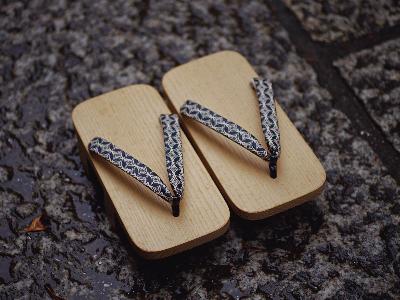|
Geta are one of Japan's traditional forms of footwear. Their origin dates back to the Nara or Heian periods. Especially after the Genroku period, when komageta were developed, and by the Edo period, they were being widely used.
In Edo, geta raised on two high struts ('ha'= teeth) were called ashida and those with low struts were geta. In Edo, geta for men were angular and those for women were roundish. In Kyoto or Osaka, high or low geta were called geta and had rounded shapes for either sex. In the Edo period, geta seem to have been tasteful footwear.
The thong to anchor the feet on geta is made from cloth: informal cloth, not formal.
For some time after the Meiji Restoration, geta were often worn with Western dress but, following the asphalting of roads, this form of footwear, along with Japanese cloth, lost their popularity.
In the last 10 years, both kimono and yukata have seen a revival in popularity, and so, too, have geta. Geta are currently changing in form, so that they are more comfortable to wear and do not hurt your feet.
Up to 60 percent of geta are produced in Matsunaga District, Fukuyama City, in Hiroshima prefecture.
In Edo, geta raised on two high struts ('ha'= teeth) were called ashida and those with low struts were geta. In Edo, geta for men were angular and those for women were roundish. In Kyoto or Osaka, high or low geta were called geta and had rounded shapes for either sex. In the Edo period, geta seem to have been tasteful footwear.
The thong to anchor the feet on geta is made from cloth: informal cloth, not formal.
For some time after the Meiji Restoration, geta were often worn with Western dress but, following the asphalting of roads, this form of footwear, along with Japanese cloth, lost their popularity.
In the last 10 years, both kimono and yukata have seen a revival in popularity, and so, too, have geta. Geta are currently changing in form, so that they are more comfortable to wear and do not hurt your feet.
Up to 60 percent of geta are produced in Matsunaga District, Fukuyama City, in Hiroshima prefecture.
| [+ADDRESS] | 
|












